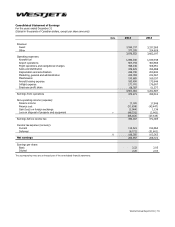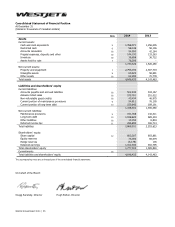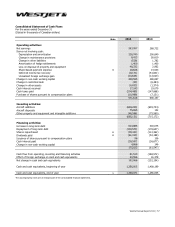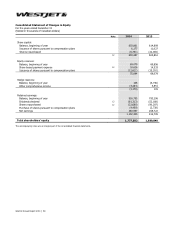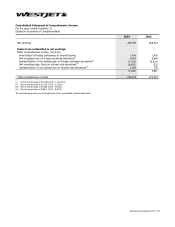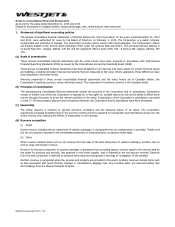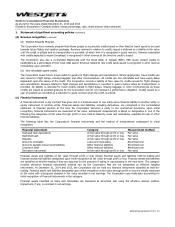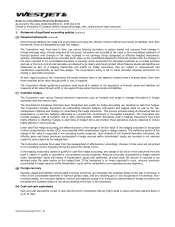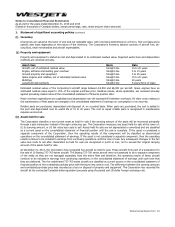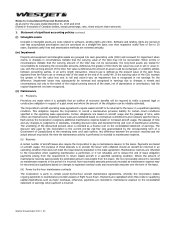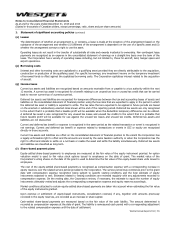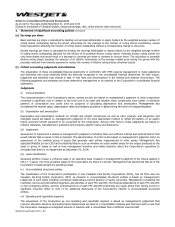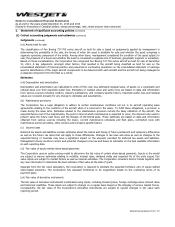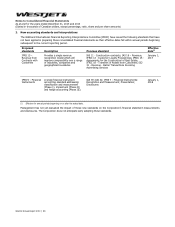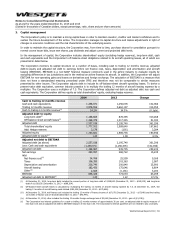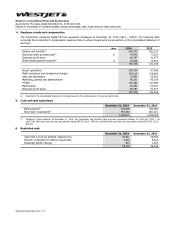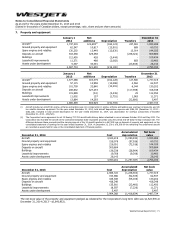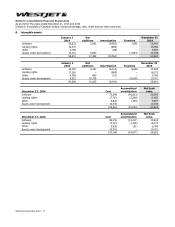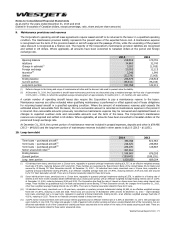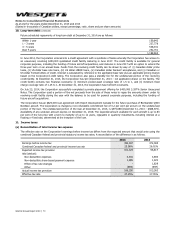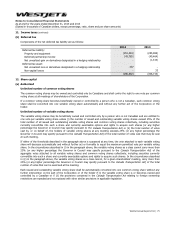Westjet 2014 Annual Report Download - page 67
Download and view the complete annual report
Please find page 67 of the 2014 Westjet annual report below. You can navigate through the pages in the report by either clicking on the pages listed below, or by using the keyword search tool below to find specific information within the annual report.
Notes to Consolidated Financial Statements
As at and for the years ended December 31, 2014 and 2013
(Stated in thousands of Canadian dollars, except percentage, ratio, share and per share amounts)
WestJet Annual Report 2014 │ 65
1. Statement of significant accounting policies (continued)
(o) Leases
The determination of whether an arrangement is, or contains, a lease is made at the inception of the arrangement based on the
substance of the arrangement and whether (i) fulfillment of the arrangement is dependent on the use of a specific asset and (ii)
whether the arrangement conveys a right to use the asset.
Operating leases do not result in the transfer of substantially all risks and rewards incidental to ownership. Non-contingent lease
payments are recognized as an expense in the consolidated statement of earnings on a straight-line basis over the term of the
lease. The Corporation has a variety of operating leases including, but not limited to, those for aircraft, land, hangar space and
airport operations.
(p) Borrowing costs
Interest and other borrowing costs are capitalized to a qualifying asset provided they are directly attributable to the acquisition,
construction or production of the qualifying asset. For specific borrowings, any investment income on the temporary investment
of borrowed funds is offset against the capitalized borrowing costs. The Corporation capitalizes interest related to the acquisition
of aircraft.
(q) Income taxes
Current tax assets and liabilities are recognized based on amounts receivable from or payable to a tax authority within the next
12 months. A current tax asset is recognized for a benefit relating to an unused tax loss or unused tax credit that can be carried
back to recover current tax of a previous period.
Deferred tax assets and liabilities are recognized for temporary differences between the tax and accounting bases of assets and
liabilities on the consolidated statement of financial position using the tax rates that are expected to apply in the period in which
the deferred tax asset or liability is expected to settle. The tax rates that are expected to be applied in future periods are based
on the enacted or substantively enacted rates known at the end of the reporting period. Deferred tax assets are only recognized
to the extent that it is probable that a taxable profit will be available when the deductible temporary differences can be utilized.
A deferred tax asset is also recognized for any unused tax losses and unused tax credits to the extent that it is probable that
future taxable profit will be available for use against the unused tax losses and unused tax credits. Deferred tax assets and
liabilities are not discounted.
Current and deferred tax benefit or expense is recognized in the same period as the related transaction or event is recognized in
net earnings. Current and deferred tax benefit or expense related to transactions or events in OCI or equity are recognized
directly in those accounts.
Current tax assets and liabilities are offset on the consolidated statement of financial position to the extent the Corporation has
a legally enforceable right to offset and the amounts are levied by the same taxation authority or when the Corporation has the
right to offset and intends to settle on a net basis or realize the asset and settle the liability simultaneously. Deferred tax assets
and liabilities are classified as long-term.
(r) Share-based payment plans
Equity-settled share-based payments to employees are measured at the fair value of the equity instrument granted. An option
valuation model is used to fair value stock options issued to employees on the date of grant. The market value of the
Corporation’s voting shares on the date of the grant is used to determine the fair value of the equity-based share units issued to
employees.
The cost of the equity-settled share-based payments is recognized as compensation expense with a corresponding increase in
equity reserves over the related service period provided to the Corporation. The service period may commence prior to the grant
date with compensation expense recognition being subject to specific vesting conditions and the best estimate of equity
instruments expected to vest. Estimates related to vesting conditions are reviewed regularly with any adjustments recorded to
compensation expense. On the vesting date, the Corporation revises, if necessary, the estimate to equal the number of equity
instruments ultimately vested and adjusts the corresponding compensation expense and equity reserves accordingly.
Market conditions attached to certain equity-settled share-based payments are taken into account when estimating the fair value
of the equity instruments granted.
Upon exercise or settlement of equity-based instruments, consideration received, if any, together with amounts previously
recorded in the equity reserves, are recorded as an increase in share capital.
Cash-settled share-based payments are measured based on the fair value of the cash liability. The amount determined is
recorded as compensation expense at the date of grant. The liability is remeasured each period with a corresponding adjustment
to the related compensation expense until the date of settlement.


